Expert Care For The Abronia Lizard
Known commonly as arboreal alligator lizards and also as just “abronia,” Abronia species are generally slow-moving, but they can quickly drop to the floor and make a hasty retreat if threatened. They can become tame after acclimating to a calm keeper, but each varies, and some may be inclined to bite. Arboreal alligator lizards are best for intermediate to advanced keepers because of their specific captive-care requirements. They are, however, hardy if maintained correctly.
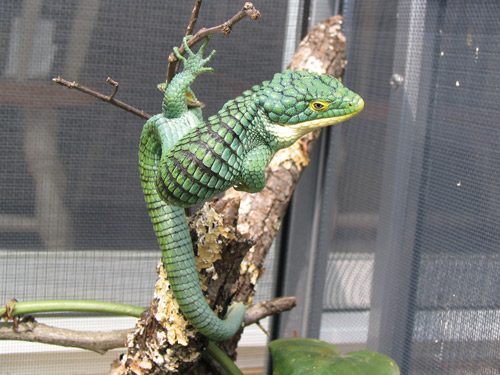
Photo by Jason Wagner
This Abronia graminea is one of the author’s largest abronia and was raised in captivity. It is a second-generation captive-bred animal.
These live-bearing lizards produce a single litter each year. They are not common in their native ranges and are limited to small geographic areas. There are some species that may already be extinct due to massive land clearing for agricultural expansion or charcoal production. In the wild, they are mostly arboreal and usually live high in the trees. However, I have found specimens on the ground and in rotting wood, or hiding in large clumps of moss. The trees they live in are generally large oak varieties, and they are typically covered with moss, ferns, orchids and most important, bromeliads. They use bromeliads as microhabitats for humidity, water and shelter, and as a source of prey items, which are abundant in the large, epiphytic plants.
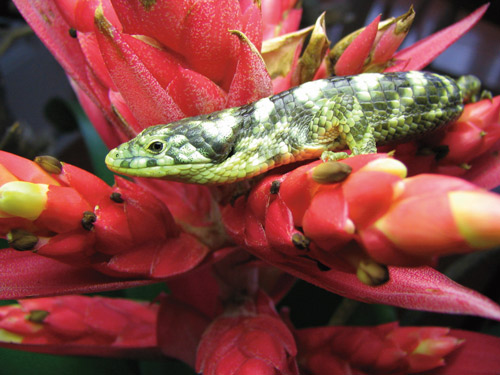
Photo by Jason Wagner
A 20-month-old, captive-bred Abronia taeniata sits on a bromeliad. These lizards use bromeliads as a microhabitat for humidity, water and shelter, and as a source of prey items.
Abronia lizards are found in several unique habitats, but they primarily inhabit cloud forests at high elevations in Central America, mainly in Mexico and Guatemala. They are also found in some instances in oak scrub and pine forest areas, again at high elevations, usually between 4,000 to 8,000 feet. At these high altitudes, there is a great deal of temperature variance between day and night, which is an important element to consider in captive husbandry. I have found that they will thrive best in a situation in which they are provided with a strong nighttime temperature drop.
The temps will range from as low as 40 degrees Fahrenheit and can be as high as 90 degrees, but those are generally the extremes. In the cold season where they live, night temps can reach below 40 degrees for short periods of time, and it may even snow on occasion. During these very cold seasons, the lizards have been found to den together in hollow trees full of rotting mulch, where the temps are likely around 50 degrees. In my experience, I’ve never observed abronia out in the open air exposed to such cold temperatures.
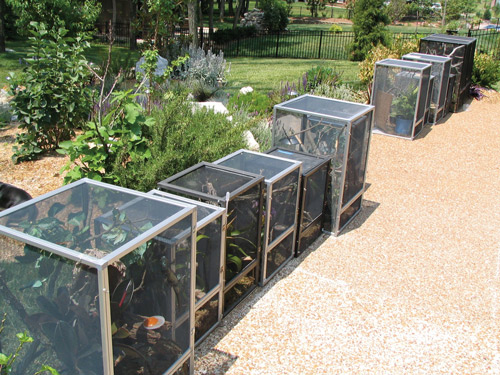
Photo by Jason Wagner
The author often places his abronia lizard terraria outdoors during the day so that the lizards may benefit from natural sunlight.
The same principle applies for the hot season and high temps. They will seek out cooler shelters, such as thick moss growing over a large rock in the shade, which may be 70 degrees, when the ambient air temps hover around 90 degrees. They are most active at temps between 75 and 80 degrees. That is when you will find them basking or searching for food, typically in the morning hours from 9 a.m. to 11 a.m. On a mild sunny day, they can be seen basking later into the afternoon, usually in the trees. When conducting research prior to setting up a captive environment for abronia lizards, it’s helpful to consult weather websites and monitor temperatures and rain patterns for Puebla, Mexico or Huehuetenango, Guatemala, as both of these regions support abronia in the wild, and being familiar with their climate will help you maintain captive abronia.
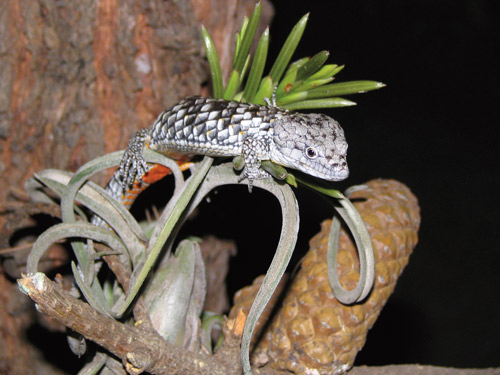
Photo by Jason Wagner
Abronia are arboreal, and wild specimens are often found in trees.
Cloud forests, by definition, are misty, foggy, high-humidity areas, and it is in this niche environment where abronia thrive. These areas typically get a lot of precipitation. The mild climate also supports a large diversity of insects, and my guess from captive observation is that abronia lizards take advantage of this. Breeding usually takes place from September to December, and seven to 14 babies are born, typically between April and June.
Enclosure Design
All-screen cages are the best choice for captive abronia. They provide adequate ventilation and the advantage of natural sunlight. For an adult pair, the cage should be at least 20 inches long, 20 inches wide and 30 inches tall. Because these are arboreal lizards, height is more important than ground space.
Keep males separately; they will fight if kept together. Babies will also fight if kept too crowded, but individuals do vary in personality and disposition. I have only seen females fight twice. Both battles were between two Abronia vasconcelosii, and the damage wasn’t too severe, mainly a nip to establish territory.
I keep my abronia lizards in large, screen cages that are heavily planted with bromeliads and orchids, and I offer plenty of climbing branches. I also provide a 2- to 4-inch layer of long-strand sphagnum moss as substrate. This substrate provides both moisture and a cool area to retire from heat. The moss should be kept moist in some areas and dry in others, such as under the basking spot. Occasionally, I let all the moss dry out completely before re-moistening some areas. I do this because short, dry spells occur in these lizards’ native environment. (Interestingly, sphagnum moss has been documented as having a natural antibacterial property, and reports indicate that it was used during World War I to dress soldiers’ wounds.)
I provide my lizards with natural ultraviolet light. I have noticed that they look more brilliantly colored when given extended exposure to natural sunlight. Though I would never recommend keeping them under such conditions, Abronia graminea will typically fade to a grayish teal color if kept indoors under incandescent lighting with little temperature variance over a long period. In nature, they are usually a brilliant emerald green.
To provide natural sunlight, I move the screen cages outdoors when the weather permits. When indoors during summer months, I use compact fluorescents that give off 7 to 10 percent UVB light, but I switch to active UV heat bulbs, such as mercury vapor bulbs, during the winter.
These lizards do not thrive in overly hot habitats. The high altitudes where they come from fluctuate in temperature, but they almost never reach more than 90 degrees. I also would not allow abronia lizards to be exposed to temperatures less than 45 degrees. I recently started keeping the cages on a concrete slab when outdoors, as I find that when the temps get too hot in the daytime, the moist moss resting directly on the flooring of a cage placed on the cool concrete provides a cool temperature gradient.
It is also important to provide shady areas within the cage for animals housed outdoors. This can be achieved with broad-leaf plants or cork-bark slabs sitting at an angle in the enclosure. Abronia lizards will die if they are left in a hot cage in full sun with no shade and no way to thermoregulate.
Feeding Abronia
I offer my abronia lizards a variety of insects. Their favorites are large, black, diurnal crickets, followed by grasshoppers. They will also take green caterpillars (such as hornworms), snails, spiders, mealworms, soldier fly larvae (I use Phoenix Worms due to their high calcium content) and roaches. I often feed my abronia by hand or with tweezers to make sure they are eating. I also assist weak or sick lizards this way.
As with all primarily insectivorous lizards, offer abronia a variety of insects with emphasis on prey items that are low in protein. Bugs full of plant matter, such as caterpillars, grasshoppers or katydids, are relished. My abronia respond especially well to green grasshoppers that are caught in a hay field. I gut-load all prey insects with a variety of leafy greens, such as kale, romaine lettuce and dandelion greens, as well as assorted fruits and vegetables. I also keep feeder insects on a substrate comprised of a mix of ground-up whole grains.
While crickets are a favorite of my abronia, I do not recommend offering crickets that are raised on chicken mash. They will contain higher levels of protein, and this could be problematic for insectivores such as abronia.
Males, in particular, slow down and eat less during the summer, just before breeding season, and all abronia slow down when temperatures drop during the winter.
Hydrate
I mist an enclosure’s plants almost daily, as well as the enclosure’s sides and the lizards themselves. Additionally, two to three times a week, I provide a dripper cup that slowly drips approximately one cup of water over a specific plant in the enclosure.
For all watering, I use tap water that has been exposed to the air for 24 hours. This removes chemicals such as chlorine from the water.
Another watering method, which I really like and am currently testing, is to use a Misty Mate pressure spray bottle. This high-pressure system emits a fine mist for up to 20 minutes, and it is excellent for simulating a cloud-forest environment.
While humidity and precipitation is necessary, it’s also equally important to ensure adequate ventilation and occasional drying out of the enclosure and substrate. Abronia lizards are not semiaquatic reptiles or swamp dwellers, and they would not do well in a water-saturated environment in the long term. Short, four- or five-day “rainy seasons” would be fine, but there should be breaks between watering that allow the enclosure to dry out. If you find mold or fungus growing in the enclosure, there is too much moisture and not enough ventilation. This condition should be avoided, because it is unhealthy for the lizards.
Rare Beauty
Abronia are rare in the wild, and with their small native habitats under a considerable amount of pressure, in some cases to the point of devastation, it’s important to do what we can to preserve them in captivity. The best conservation solution would be to establish wild reserves in their native habitat where they can be safeguarded from land-clearing practices, but there is also considerable conservation value in learning how to establish them successfully in a captive environment. When abronia are kept under the correct conditions, they are quite hardy. Babies can be kept under the same conditions as the adults, though they are especially susceptible to problems if their enclosures are too warm. Pay close attention to calcium intake, too, as young lizards are growing. They do best if supplemented on calcium-coated crickets at every feeding for the first few months, combined with as much natural sunlight as possible given your particular location.
Breeding Abronia
Abronia lizards are live-bearers. Adults will typically breed in their second year, when they are full-sized and sexually mature. I have seen breeding activity as early as July and as late as November. The pair may stay “locked up” for as long as 24 hours.
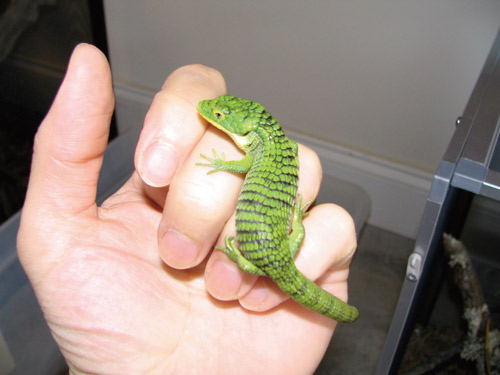
Photo by Jason Wagner
Abronia are live-bearing lizards that produce one litter of seven to 14 babies a year.
Babies are typically born from March to June. My females have produced seven, 10, 11 and 13 babies at a time. Typical gestation period is six to eight months, and babies in a single litter are born over a period of one to three days. In my experience, females will not eat their young, but I don’t trust the males or other adults.
A gravid female will develop “chalk sacs” on the sides of her jowls before giving birth, likely as a calcium supply. She will also noticeably gain weight. Perhaps the toughest part of keeping abronia is raising babies. They have all the same requirements as the adults, but they are much more susceptible to overheating and death from high temperatures. I have found that anything over 85 degrees is dangerous for them.
Young lizards also may battle each other over space, so it is best to keep them in small groups of two or three to an enclosure. I’ve tried keeping them separately in small Kritter Keepers, which seemed to work OK, but they didn’t have optimum exposure to UV lighting or ventilation. However, keeping them that way did allow me to ensure that they were catching and eating their prey.
Finding and offering small insects is very important for the first three or four months, and this can be challenging. I’ve caught small grasshoppers by hand and hunted for little green inch worms in the lawn. I’ve used a net to do field sweeps, and I also offer the normal crickets and smaller mealworms. When catching your own insect prey, you must be sure you are not doing so in areas that may have been sprayed with chemicals that could be dangerous to your lizards.
I’ve recently discovered soldier fly larvae (marketed and sold as Phoenix Worms), which are a good size and move slowly enough to be devoured by young lizards. They are high in calcium, too, which is good at this stage.
My best experience has been to keep the babies exactly as the adults: in planted screen enclosures measuring 20 inches long, 20 inches wide and 30 inches tall. I had to use aquarium silicone to plug the small holes in the corners of my screen cages so the small feeder insects couldn’t escape. It’s important to offer plenty of small insects, but don’t overwhelm the lizards. It is never a good idea to offer so many that they go uneaten. Observe your animals to determine how many insects they typically consume and stick with that amount. Feeding young abronia three times a week is fine. Supplement insects with calcium powder at every feeding and with vitamins once a week.
A Rare Gem
There are approximately 28 Abronia species known to science. Although not readily available in the pet trade, you can find them, on occasion, offered in small numbers through a captive-breeding program or at reptile expos in Europe. They are generally expensive, because they are so rare. Species that are good candidates for future breeding projects in collaboration with the Mexican and Guatemalan wildlife management agencies are: Abronia graminea, A. taeniata, A. deppei, A. martindelcampoi, A. vasconcelosii and A. lythrochila. Depending on who you ask, species that are under threat of extinction or are much more rare in wild populations and should be targeted for conservation efforts in situ by qualified institutions include A. chiszari, A. reidi, A. ornelasi, A. ramirezi, A. mitchelli and A. bogerti.
Native Legend
In their native habitat, many of the local people believe abronia to be venomous, and in some cases, they have a great fear of these harmless lizards. They even refer to them as “escorpion de arbol,” which is Spanish for “tree scorpion.” This may be because of the lizards’ willingness to aggressively defend themselves in the wild with a quick, and sometimes painful, bite. Unfortunately, because of this common misperception, locals often kill abronia on sight.
When visiting Central America, I take every opportunity to educate the residents on the fact that abronia are not a potential health risk. Sometimes, I have actually allowed a lizard to bite me in front of them, just to show that there is no danger. This usually is enough to convince anyone that the animal is harmless, although once there was a skeptic who stated that I must have built up an immunity to the lizard’s toxins.
Ant Alert
If keeping abronia lizards outside, be wary of ants that can scout and mount surprise attacks, particularly against young lizards.
Watch the Heat!
I believe the primary killers of captive abronia are most likely excessive heat and the lack of a temperature gradient. Unless you want to breed them, maintain pets at room temperature constantly, with a warmer end and a cooler end in the enclosure, and don’t go out of your way to drop the temperature at night. If you follow this simple rule in regard to temperature, you’ll go a long way toward enjoying your pet abronia lizards for years to come.


